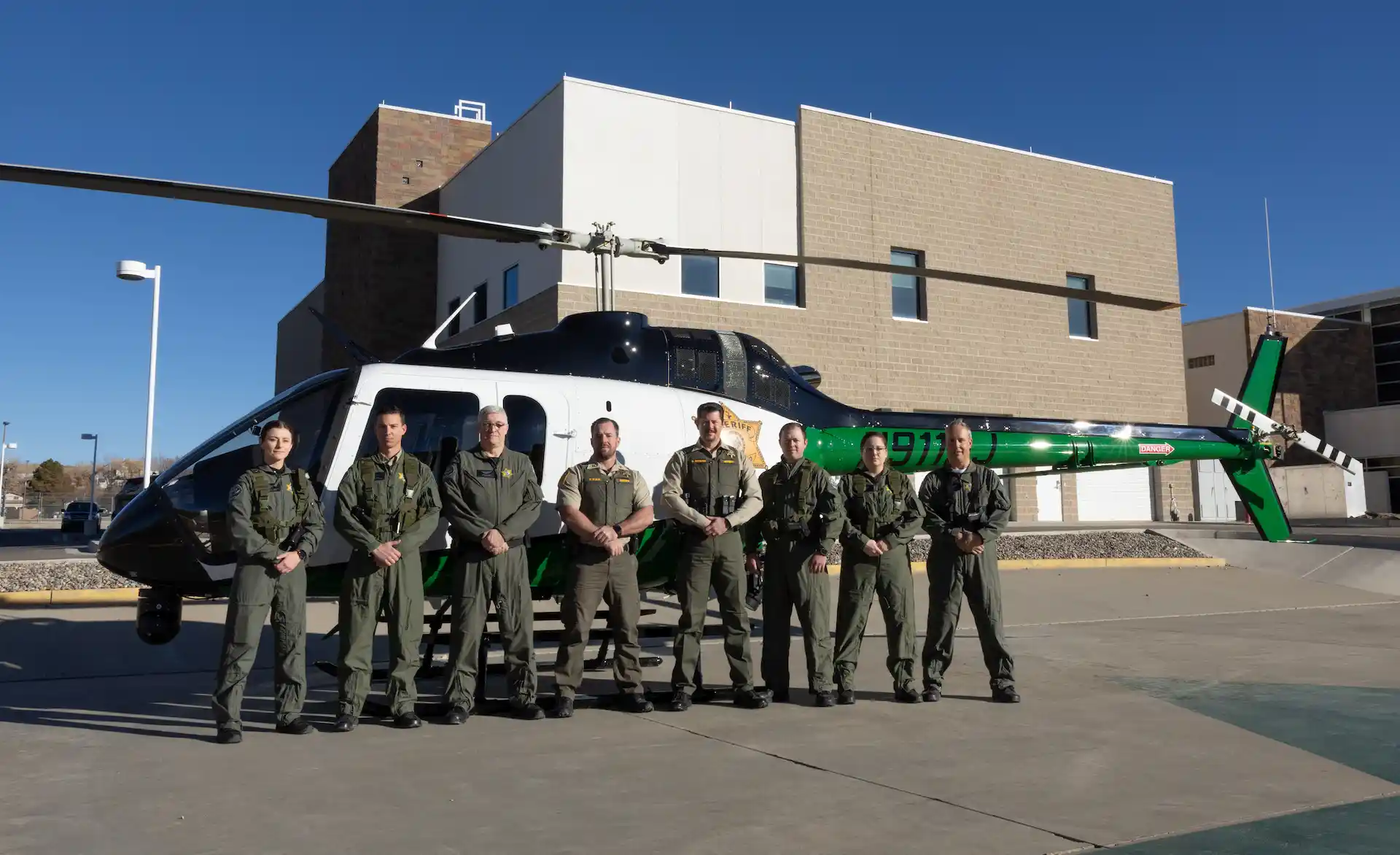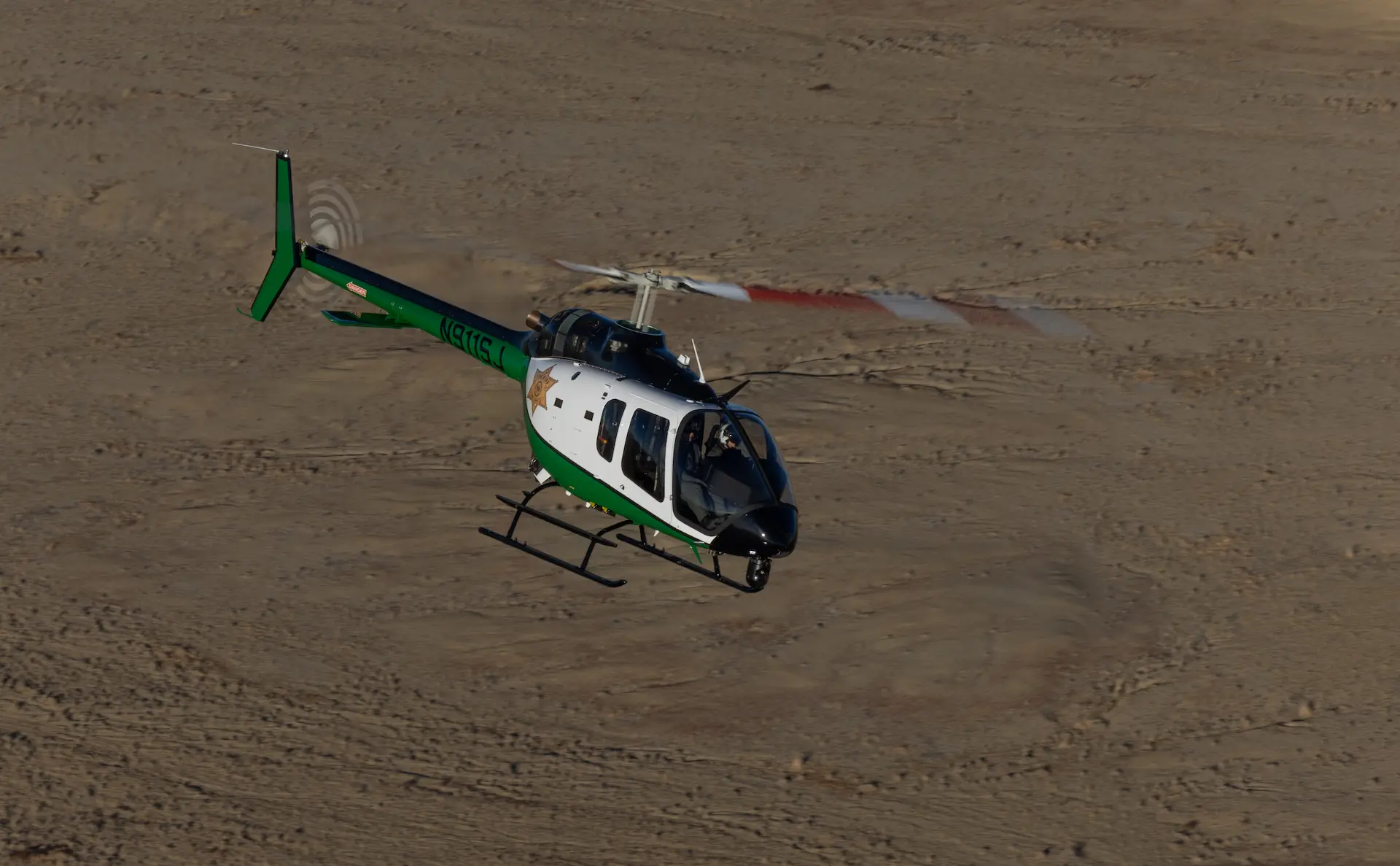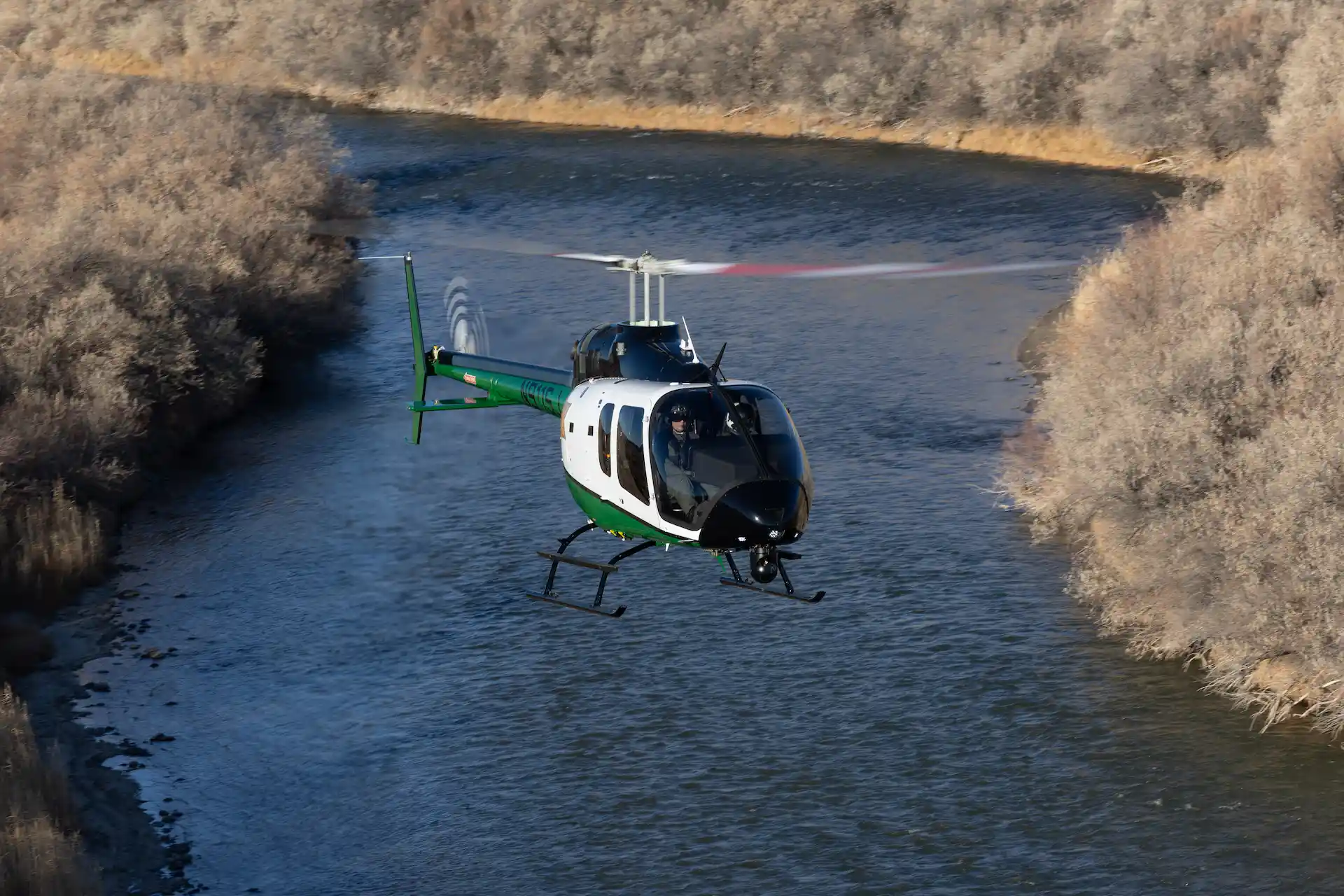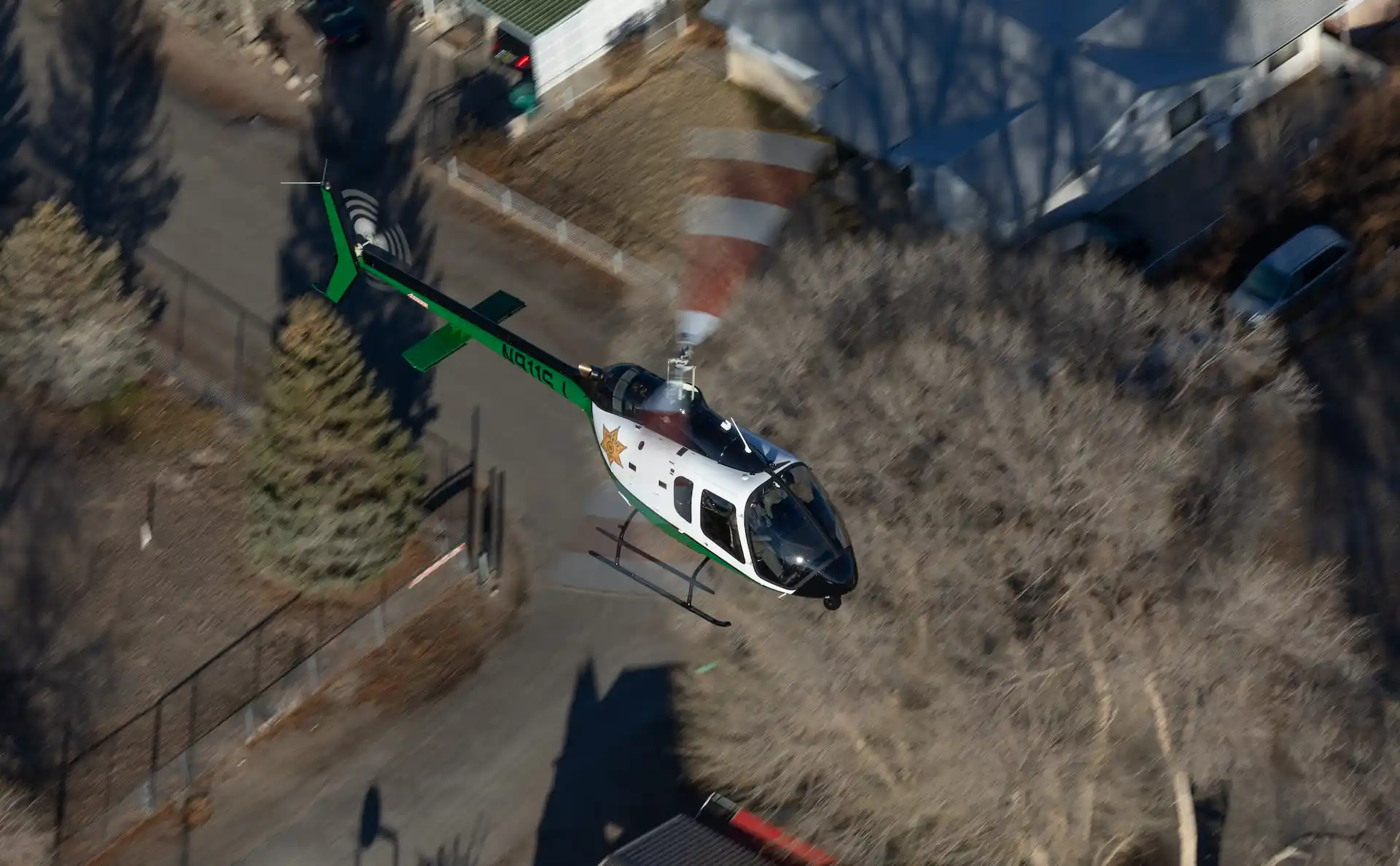After operating ex-military OH-58 Kiowas for almost 25 years, the San Juan County Sheriff’s Office has acquired a new Bell 505 JetRanger-X to supplement the aging and less capable old aircraft. The current sheriff and crews talked to HeliOps about their aviation operation and the new aircraft.
Early Days
Prior to 1999, the San Juan County Sheriff’s Office in New Mexico did not have an aviation capability. In that year however, ex-US army pilot and then Sheriff’s Office Captain Marvin Stock began investigating the feasibility of acquiring air assets through the US’ LESO (law enforcement support office) 1033 program that enables law enforcement agencies to obtain surplus/retired military equipment, including aircraft. Current Sheriff R. Shane Ferrari explained, “Captain Stock started working through the program to get our very first helicopter, an OH-58 Bell Kiowa. Michael Davidson was the Sheriff at the time, and he looked at it as more of a project than an actual program, to see how it would work here in San Juan County but they very quickly recognized the need for a helicopter in our area because our nearest air asset is 160 miles away in Albuquerque.”
Stock and his brother David – another military pilot – became the Sheriff’s office pilots as the aviation program took shape and after Stock retired from the Sheriff’s office, the pair continued flying as contract pilots for the unit. The first full-time unit member was a deputy who had some flight experience. He came on board as the A&P mechanic and was also trained up to take over as the primary pilot. Joining later was Matt Markle, a former deputy who left the Sheriff’s office to pursue a helicopter pilot career in the private sector, but who returned to the office in 2013 because of its aviation program and remains on the unit today.

Big Country
The coverage area is vast, as San Juan County is 5,500 square miles – larger than the three smallest US states – and that is without including requests for aerial support from adjacent states in the four-corners region. Established in 1887, San Juan County was the last bastion of the ‘wild west’, with an extensive, rich history and two-thirds of the county is covered by the sovereign Navajo Nation, the largest native American reservation in the US. Although the Sheriff’s office has no jurisdiction over native Americans in that nation, it does have authority over any non-natives. “Although we have no jurisdiction over them, we still want to be good neighbors and if required, provide assets to them in their time of need,” Ferrari commented. The Sheriff’s office provides air support for the whole four-corners region, a very large area with remote and difficult terrain where four US states meet. “It was the ground units that went out there and did the work and so the idea of an aerial support unit quickly turned into a real need, not just for the county but for the four-corners as a whole,” Ferrari stated. Despite its size, the county is relatively sparsely populated, with around just 116,000 residents.
Sergeant Gary Mauldin runs the air unit. He joined the Sheriff’s office in 2008 and went onto the unit in 2009 as a TFO. He then trained to upgrade from his fixed-wing license to helicopters and became a unit pilot, progressing through PPL to CPL, instrument rating, CFI qualification and NVG rating. Mauldin and Markle are the unit’s two unrestricted pilots, able to conduct all missions, day or night and alternating week-about on call. The other pilot is mission-capable day only and is currently at Bell Field Maintenance course. The unit’s four TFOs are each on call for one week in four and all flight crew live relatively close to base to meet the twenty-minute maximum response time to the hangar.
The office’s aviation unit supports agencies in parts of Colorado, Utah, and Arizona, as well as in its own New Mexico jurisdiction and, although a restriction imposed on aircraft obtained through the 1033 program is that reimbursement cannot be sought from any other agency for services provided by that aircraft. That restriction does not apply to aircraft obtained through other channels and owned by the Sheriff’s Office however, such as the new Bell 505 that was recently purchased and arrived at the unit in mid-November 2023. Therefore, it is feasible that in the future, some arrangement may be made to receive extra funding from agencies and states that receive aerial support from the unit under mutual aid agreements but until now, no such funding has been available.

San Juan Sheriff’s air unit is one of only three aviation units in New Mexico that qualify for the increased state funding that became available in the aftermath of 9/11 and Ferrari explained that that funding had allowed the unit to acquire some advanced specialist equipment for the unit’s aircraft, including a FLIR system, NightSun searchlight and long-distance loud hailer system. By that time, the office had acquired a second OH-58 to add a backup aircraft and increase dispatch reliability. The second machine was lower timed and in better shape than the original Kiowa, so the advanced equipment was fitted to it and it then became the unit’s primary aircraft.
New Bell
The purchase of the new Bell has allowed the unit to ‘sideline’ the original OH-58 as a source of spares; a huge benefit as Ferrari explained, “For a while we had a great opportunity to acquire parts from the military, but it now no longer supports the Kiowa, so we’ve been given approval to cannibalize the old Kiowa for spares. Thanks to ex-military parts, the 1033 program and networking with other law enforcement operators of the OH-58, in the past we’ve been able to run this program on a shoestring budget of just $100,000 a year. We’ve been very frugal with the money we had and very smart and dedicated in finding the funds and resources we needed to keep this program alive.”
Once the military stopped supporting the OH-58, maintenance and related costs increased and the unit has been creative in keeping the program alive with limited funding. For example, when the opportunity arose to obtain crated engines, spares, and a downed aircraft from the Jicarilla Apache through the 1033 program, it was found that the engines were not suitable for the unit’s Kiowas, so they auctioned them off and the resulting funds helped cover overhaul and maintenance costs for some time. Retaining one Kiowa in service enables the unit to keep an aircraft available as a backup machine and, more importantly for training, something that in the past was all conducted by outside agencies, imposing a major cost on the unit.

The unit’s aviation manager has been approved to attend instrument instructor training so in future the training will be able to be carried out in-house. Fortunately, the parts Kiowa had a recent engine rebuild and the other machine still has several hundred hours left on its powerplant, so the unit now has sufficient spares to maintain the airworthy Kiowa in a good operational state for another ten years or so. “The 505 is certificated so we will now be able to use it for check rides, something we couldn’t do in the 58,” advised Mauldin. “It’s hard to find helicopter pilots that want to be cops but it’s easy to find cops who want to be pilots, so now we’ll be able to train and move up our own deputies who are interested.”
Financial Planning
With the new 505 entering service, it is inevitable that costs will increase but Ferrari commented that the unit has, over the last twenty-plus years demonstrated good financial stewardship of tax dollars and proven its capabilities and the necessity for the program. “We’ve got to where the state, our county commissioners and our legislators understand the importance of this program so we’re hoping that we’ll see an increase in our funding. Now that this is our own aircraft, we’re also investigating how we can partner other agencies for additional funding as mutual aid.” He added that the office is extremely fortunate that San Juan has a very supportive County Commissioner, County Manager, legislators and county officials who have been willing to fund important assets for the unit.
Until now, the unit has always operated on a part-time basis, usually flying Thursday, Friday and Saturday, and in the evenings. With such a large area and so many surrounding agencies that may require aerial support, there is an argument that the unit should become full-time, but Ferrari pointed out the issues relating to such an expansion. “First off, there’s the funding issue. If the aircraft is to operate for significantly more time, there are all the mechanical and maintenance costs associated with that, plus personnel and other back-end costs, so it’s a question of whether we could get sufficient additional funding. Then there is the question of what work is required and how much of it there will be. If they are just flying around on patrol, that will be in our local San Juan County area and at this point I don’t believe there is enough work for them to be full-time up in the air, seven days a week,” he stated. The unit’s budget is based on a total of around 250 hours per year although the actual current flight hours sit around 150-200 annually.

“We really focus our operations on augmenting our manpower and assets during our peak hours. We keep track of what our call volume is, what areas the majority of calls originate in and that’s where we concentrate our efforts,” advised Ferrari, while Mauldin added, “We arrange all our scheduled patrol flights Thursday through Saturday, 4 p.m. to 10 p.m. because that’s when we have the highest volume of priority-one calls. Outside of those hours though, we’re always on call.” Mauldin stated that scheduled patrol accounts for around twenty hours each month, while the majority of callouts are for search and rescue operations in a wide variety of remote locations and environments. Such occasional incidents as pursuits and high-risk warrant executions trigger either a call to launch or to standby on the ground, ready for immediate takeoff, while high-level surveillance for narcotics operations and similar is flown at up to 12,500ft, so the unit’s crews have a wide variety of missions and operational profiles.
Supportive
Alongside its expected law-enforcement role, the unit also supports agencies that are not law-enforcement related, such providing an aerial platform for the fire department when it is necessary to gain an aerial overview of a blaze to accurately assess its movement and plan the optimum firefighting tactics. “We’ve had incidents such as a mine spill in Silverton, Colorado where we assisted the EPA, taking their personnel up to assess the movement of mining-related pollutants coming down the river from the spill site into our area and plan the best mitigation methods,” Ferrari reported.
The replacement process for the helicopters began when Ferrari was the under-sheriff, and he approached the then-sheriff to address the various drawbacks of the unit’s aging machines. “Although I have complete trust in our people and the way they maintained our helicopters, we just needed to face the fact that the aircraft were getting old. Parts are harder and harder to come by, so our expenses are higher,” Ferrari related. “Part of that discussion now is also where drones play a role and fit into law enforcement aviation, particularly in regard to constant surveillance. Drones only last so long in the air and we still have a permanent need for manned aircraft because we’re in a remote area and there are times when you have to land for search and rescue or to transport personnel. Even though they are primarily surveillance aircraft, there are those occasions where we need something with those capabilities.” He advised that fixed-wing alternatives were briefly considered, but it was recognized that the lack of sufficient accessible landing areas in much of the county made them unviable.

Ferrari lists the primary advantages of the law-enforcement helicopter as increased safety for officers on the ground, reduced call-response times and the ability to handle situations very quickly, which also reduces manpower requirements on the ground. “They allow us to establish and surveil perimeters more quickly and effectively, plus it’s well known by our criminal element that we have helicopters, which adds safety for our officers on the ground. It all just adds up to make us a more professional and capable law enforcement agency for the four-corners,” he noted.
Replacement Aircraft
According to Ferrari, the need for a replacement aircraft finally coincided with a period of relatively high income for state project funding. The choice of the Bell 505 was made largely by the aviation division, after consideration of what capabilities were necessary for the unit’s roles, what was available on the market, what other enforcement agencies were doing and the ease of transitioning the unit’s personnel to a new type. “Because the Kiowas were owned by the military, another thing we were faced with was that if there was any type of conflict or situation that needed those aircraft back in service, they could just take them back from us and our area’s become very dependent on our aviation unit,” he added. “This is a unique area. Right now, we’re in the high desert but if you go 45 minutes that way, you’re in the ponderosa pines with very high elevations. Because our environment varies from desert to mountainous, we needed an aircraft that fits every situation we deal with and every environment we’ll need to operate in. That’s how we ended up choosing the 505.”
Mauldin commented that the Bell 505 marked a major step up in technology and systems from the OH-58. “This new helicopter has a Garmin G1000 all-glass cockpit so it’s a huge change,” he said. The new mapping system is from ShotOver but that is not that different, as San Juan was one of the very first agencies to trial and adopt the original Churchill mapping technology. While Mauldin was already familiar with the G1000 from his fixed-wing flying, Markle trained on ‘steam gauges. “That’s also what we had in the 58 but then we got the G500 and worked with it for a couple of years, which was a real stepping-stone for me to learn. The G1000 has a lot more functionality but it’s nice enough and so similar that it hasn’t been as overwhelming as I expected,” he remarked.

Advancing
The new aircraft’s flight characteristics, performance, technology and ergonomics are a major advance over the old Kiowas and Mauldin compared the transition to stepping out of a 1970s Ford pickup into a new Corvette, commenting, “The 58 doesn’t really like going over 80kts, as it starts to shake and vibrate. Me and Brittany (TFO Brittany Allison) flew this new aircraft back from Dallas at 120kts most of the way and it was smooth as could be.” Markle noted, “This thing’s a lot faster and a lot more responsive than the 58.” The crews identified the new Wescam MX-10 as a notable upgrade over the Kiowa’s FLIR 8500, and the ability to integrate it with the mapping system and extra functionality of the G1000 made for a massive advance in both capability and usability. “I think it’ll mean less workload for the TFOs and less workload for us too,” opined Mauldin. NVGs are regularly used by pilots and TFOs on night missions so the new Bell is fully NVG compliant.
The San Juan unit crewmembers are all highly motivated and enthusiastic. 11-year TFO and TFO-trainer Allison remarked that she took the position largely for the adrenaline-charged work environment it offered – a sentiment echoed by fellow TFO and gaming afficionado Nikki Large, who was getting burned out in her previous post and sought the position’s complexity and adrenaline. Tyler Abernathy (6 year TFO) engaged in several fly-alongs and became attracted by the complexity and technological challenges involved in a TFO’s duties, while Avery Washburn (4 years) expressed a lifetime interest in both law enforcement and aviation and said he saw the TFO’s job as super-cool, exciting and ‘bad-ass’. At least two of the TFOs also express an interest in possibly progressing to a pilot position in future, something that will be of great benefit to the unit considering the probable need for additional or replacement pilots in the next two or three years.
The TFOs all appreciate not only the capabilities and automated features of the new technology, but also the 505’s effective heater and the extra space and headroom its cockpit offers. “In the 58 I’d have to lean forward to flip up the NVGs, otherwise they’d hit the roof. The camera technology is pretty insane, and it has a far superior zoom capability. You had to kind of fight the old camera a lot because it wandered but the new one has a couple of buttons you can push to have it lock on and assist you with tracking vehicles. That lets you put the joystick down and do other things with your hands,” commented Abernathy. “We also have the ability to send live screenshots via email of what we see to deputies on the ground or anyone in our contacts list,” added Allison. “We have a much better view out, down and rearwards. We don't have a barrier separating us from whoever's in the backseat, in case they’re not used to being in the air and start freaking out. The backseat is a lot bigger in the 505 so if we're out on a mission and a cop gets shot, we have the capability to land, fold up our backseats, load them in and go straight to the hospital without waiting for ground units to come and get him.”
Markle noted that the 505 has a greater payload capacity but is more sensitive to CoG limitations and he acknowledged that although the OH-58 is more forgiving regarding payload placement, experience and a little thought is all that will be required to manage the loads in the 505. He also anticipates much greater tail-rotor authority than in the 58.
With only three more years to go as Sheriff, Ferrari is relieved that the modernization of the unit has been carried out before the next Sheriff takes office, as it was his great concern that another Sheriff may not see the value in maintaining an air unit equipped with obsolete and aged aircraft. “Succession planning is crucial, because we have two pilots that could retire in the next couple of years if they want. I’m extremely proud that we’ve been able to do this in a mid-size Sheriff’s office in the middle of nowhere, something that started out as a trial project and has become a vital regional asset. Our predecessors created this program and we’ve been able to sustain it and can see it continuing in the future. Our next step is a new hangar and I take a lot of pride in that I can walk out of here in three years and see what we’ve done to improve our aviation unit and the agency itself,” Ferrari remarked.

Ferrari is adamant that the key thing that makes the program work is its personnel. “These are certified deputies that have amazing skillsets. Former fixed-wing pilots that we’ve turned into helicopter pilots and an ex-military A&P mechanic. We’ve been blessed to have these people here, who’s dedication and skills allow this program to work and they exceed expectations every time.” Ferrari was Lieutenant overseeing special operations, including the aviation unit, some years ago and started with little or no aviation knowledge. Because of that, he stressed that he built crucial relationships with the then mechanic and pilot deputy, trusting their expertise as he learnt himself. “I still listen extensively to our pilots and trust their judgement on mission safety and decision-making 100 percent. I’m lucky to lead these guys because they are the ones that do the work and they make me look good,” he concluded.
 HOME
HOME



